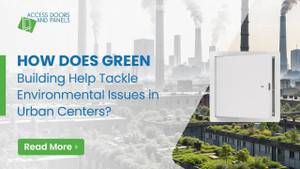How Does Green Building Help Tackle Environmental Issues in Urban Centers?
Posted by Access Doors and Panels on 24th Jul 2024
Urbanization, a global trend, contributes to increased energy consumption, air pollution, and water scarcity. Green building practices address these urban environmental issues by incorporating innovative strategies and technologies to reduce ecological footprints.
Green buildings provide social and economic benefits, such as improved community health and increased property values. They also promote a more sustainable city future. Implementing green building practices can create vibrant, prosperous, and responsible cities that focus on the health and well-being of all residents.
Benefits of Green Building in Urban Areas
Energy-Efficient Building Strategies and Technologies
Green buildings aim to reduce energy consumption through a multi-pronged approach. These include a high-performance building envelope, which uses high-quality insulation materials with superior thermal resistance, and high-performance windows that allow natural light to penetrate. A well-insulated and sealed building envelope can reduce heating and cooling energy use.
Energy-efficient buildings also incorporate energy-efficient LED lighting and appliances, which consume less power than traditional incandescent bulbs, reducing energy consumption. Energy Star-certified appliances can use less energy than conventional models. Green buildings also generate clean energy on-site, reducing a building's dependence on the utility grid.
Water Conservation Strategies and Technologies
Urbanization increases the strain on municipal water supplies, leading to the adoption of water-conscious strategies in green buildings. Low-flow plumbing fixtures, rainwater harvesting systems, and water-efficient landscaping are among the methods to reduce water usage in green buildings.
Low-flow toilets can conserve up to 4,000 gallons (about 15141.64 L) of water per year, while rainwater harvesting systems capture rainwater through gutters and downspouts, reducing reliance on municipal water supplies by 30–50%.
Water-efficient landscaping, which promotes drought-tolerant plants and native vegetation, can save up to 550 gallons (about 2081.98 L) of water per month, showcasing the large water-saving benefits of these landscaping practices.
Implementing these strategies results in large water conservation benefits, including reduced annual potable water use, reduced pressure on municipal water supplies, and minimized wastewater generation.
Improved Air Quality Strategies and Technologies
Green buildings are a promising solution to urban air pollution as they focus on improving indoor air quality through innovative technologies and practices. Green roofs and walls act as natural filters, absorbing pollutants and dust particles while releasing oxygen and regulating building temperatures. They can remove up to 80% of airborne particulate matter from urban environments.
Green buildings also use enhanced ventilation systems incorporating advanced air filtration technologies to remove contaminants and allergens before they can affect occupants.
Additionally, strategically placed fire-rated access doors, like UL-listed BA-FRI Fire-Rated Insulated Access Doors, improve air quality by providing a superior barrier against smoke and fire infiltration. These doors maintain integrity during a fire, helping slow down the spread of fire for a limited period.
Urban Heat Island Mitigation Strategies and Technologies
Urban heat island effects are a significant issue in urban landscapes due to dark pavement and minimal greenery. Green buildings can mitigate this by employing strategies that promote cooler environments. Reflective roofing materials, strategically placed windows and overhangs, and landscaping with trees and shrubs can reduce cooling energy use by 30% or more.
Green roof technologies, such as vegetation and evaporative cooling, act as natural cooling systems, lowering peak roof temperatures compared to traditional roofs. Additionally, strategically placed roof skylights can be integrated with light shelves to maximize natural daylight penetration deep into the building, reducing reliance on artificial lighting and contributing to energy savings.
These strategies contribute to a cooler urban environment, reducing peak summertime temperatures, decreasing energy demand for cooling systems, and improving thermal comfort for occupants and pedestrians.
Extra Benefits and Considerations
Green buildings offer many advantages beyond environmental benefits, including improved occupant health, reduced operational costs, and enhanced building resilience. They reduce waste generation by utilizing recycled or sustainably sourced materials, conserving natural resources, and promoting waste reduction in construction. They improve occupants' health and well-being, reducing absenteeism and employee well-being.
However, implementing green practices presents challenges such as higher initial costs, ongoing education and awareness campaigns, and supportive policy frameworks. Despite these difficulties, the long-term benefits of green buildings are undeniable, and as technology advances, the initial cost is expected to decrease. Cooperation among stakeholders can unlock the full potential of green buildings for a more sustainable future.
LEED certification is a globally acknowledged green building rating system that provides a framework for planning, constructing, and operating high-performance green buildings. By striving for LEED certification, green building projects can ensure they implement best practices for environmental responsibility and sustainability.
Conclusion
Sustainable construction practices, such as green building, are powerful solutions for addressing environmental challenges in urban centers. They reduce energy and water consumption, improve air quality, and mitigate the heat island effect. As technology advances, green building practices will become more cost-effective and efficient.
Urban planners, architects, project managers, sustainability consultants, and commercial property developers have the power to shape cities' futures. Innovating and collaborating are essential for cities to evolve into sustainable economic hubs and responsible environmental stewards. By exploring green building resources, connecting with sustainability experts, and championing green building practices, we can construct a greener, more sustainable future for urban communities.
Ready to build a greener future? Access Doors and Panels is also committed to promoting green building practices and offering various access solutions to help create a sustainable urban environment. Request a quote now or call (800) 609-2917 to discuss your green building project. We'll be happy to help you.

